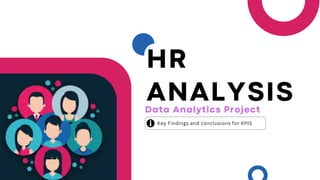
HR ANALYSIS pdf.pdf
- 1. Key Findings and conclusions for KPIS Presented By: Group 1 Data Analytics Project HR ANALYSIS
- 2. Average Attrition for all departments Average Hourly rate for Male Research Scientist Attrition Rate vs Monthly Income stats Average working year for each department Job Role vs Worklife Balance Attriton Rate vs Year since last Promotion 1. 2. 3. 4. 5. 6. K P I s
- 3. That the company has made efforts to achieve gender diversity and is working towards creating a balanced and inclusive work environment. Indicates Can help reduce biases and stereotypes that may exist in the workplace. A balanced GENDER REPRESENTATION Companies should also strive for diversity in terms of race, ethnicity, age, sexual orientation, and other dimensions of diversity. Future goals Gender Distribution
- 4. Attrition Rate within Departments The attrition rate across departments refers to the percentage of employees who leave a specific department within a company over a specified period of time. High attrition rates may indicate underlying issues such as low job satisfaction, ineffective management, or other organizational challenges that may need to be addressed. In some industries, especially those with high turnover rates (e.g., retail or hospitality), a 16% attrition rate might be considered normal. In others, particularly in more stable or specialized fields, it could be considered high.
- 5. Hourly Rate Average Hourly rate for Male Research Scientist In an equitable workplace, all research scientists, regardless of gender, should receive equal pay for equal work. Pay should be determined based on factors such as experience, qualifications, responsibilities. It's important to note that paying different rates based on gender for the same job is unethical. Comapny by far adheres to this ethical Practice.
- 6. By comparing these two metrics, a company can gain insights into potential relationships between employee turnover and income levels Attrition Rate vs Monthly Income stats
- 7. Perceived imbalance between the demands and expectations of the job role and the ability to maintain a healthy work-life balance Job Role vs WorkLife Balance could include long working hours, tight deadlines, or high levels of stress. challenging to dedicate enough time to family, leisure, or self-care. it can lead to burnout, stress-related health issues, strained relationships, and reduced overall well-being. Employers may need to consider policies and practices that support work-life balance, such as flexible work arrangements, wellness programs, and clear communication about expectations. WHY? Suggestions
- 8. A t t r i t o n R a t e v s Y e a r s i n c e l a s t P r o m o t i o n A correlation between the time since an employee's last promotion and their likelihood of leaving the company Employees may view promotions as an important factor in their job satisfaction and retention. If they're not seeing career growth or recognition for their efforts, they may be more inclined to leave.
- 9. Average Working Years A 20-year average suggests that the company has a significant number of long- term, experienced employees. This can be a sign of stability and institutional knowledge. Opportunities for internal promotion and succession planning On the other hand, if there is a lack of newer employees, it might suggest that the company could benefit from fresh perspectives and skills brought in by new hires.
- 10. CONCLUSION The data indicates that there are areas of concern regarding job satisfaction within the organization. Employees may be experiencing challenges or dissatisfaction with certain aspects of their work environment. Engaging in this project has been a valuable opportunity for skill development and refinement. We have strengthened our proficiency in Excel, Tableau, Power BI, SQL and Data Analysis